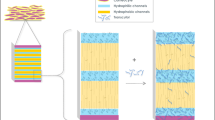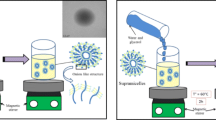Abstract
Transdermal permeation of lornoxicam, one of potent non-steroidal anti-inflammatory drugs, was studied in vitro with various vehicles and fatty acids using hairless mouse dorsal skin and human cadaver full skin. Vehicles used were diethylene glycol monoethyl ether (DGME), propylene glycol monocaprylate, propylene glycol, oleyl alcohol, dimethyl sulfoxide (DMSO) and others. Various fatty acids were employed as enhancers. Among pure vehicles studied, only DMSO showed permeation from saturated solutions. In the case of DMSO–DGME co-solvent, the higher the DGME ratios were, the lower the fluxes were. The addition of fatty acid (3 w/v %) increased the permeation in the rank order of linoleic acid (LOA) ≥ oleic acid ≥ lauric acid > capric acid > caprylic acid. Enhancement ratios ranged from 2 to 37 compared to the flux without fatty acid. Lornoxicam flux decreased in inverse proportion to the concentration of triethanolamine (TEA), which was used as a salt former and solubilizer. However, the flux increased linearly as the donor dose increased even in the presence of TEA. Using human cadaver skin, the permeability of lornoxicam was much lower than that using the hairless mouse skin, but fluxes increased as the concentration of LOA increased. These results indicate the feasibility of lornoxicam transdermal delivery with a combination of fatty acid and TEA in DMSO or DMSO–DGME cosolvents.







Similar content being viewed by others
References
Ammar HO, Ghorab M, Mahmoud AA, Makram TS, Noshi SH (2012) Topical liquid crystalline gel containing lornoxicam/cyclodextrin complex. J Incl Phenom Macrocycl Chem 73:161–175
Balfour JA, Fitton A, Barradell LB (1996) Lornoxicam: a review of its pharmacology and therapeutic potential in the management of painful and inflammatory conditions. Drugs 51:639–657
Barry BW (1983) Dermatological formulations. Marcel Dekker, New York, pp 49–94
Bonnabry P, Leemann T, Dayer P (1996) Role of human liver microsomal CYP2C9 in the biotransformation of lornoxicam. Eur J Clin Pharmacol 9:305–308
Buritova J, Besson J-M (1998) Dose-related anti-inflammatory/analgesic effects of lornoxicam: a spinal c-Fos protein study in the rat. Inflamm Res 47:18–25
Cable CG (2003) Dimethyl sulfoxide. In: Rowe RC, Sheskey PJ, Weller PJ (eds) Handbook of pharmaceutical excipients, 4th edn. Pharmaceutical–American Pharmaceutical Association, London–Chicago, pp 219–221
Fang L, Kobayashi Y, Numajiri S, Kobayashi D, Sugibayashi K, Morimoto Y (2002) The enhancing effect of a triethanolamine-ethanol-isopropyl myristate mixed system on the skin permeation of acidic drugs. Biol Pharm Bull 25:1339–1344
Fang L, Numajiri S, Kobayashi D, Morimoto Y (2003) The use of complexation with alkanolamines to facilitate skin permeation of mefenamic acid. Int J Pharm 262:13–22
Ganem-Quintanar A, Lafforgue C, Falson-Rieg F, Buri P (1997) Evaluation of the transepidermal permeation of diethylene glycol monoethyl ether and skin water loss. Int J Pharm 147:165–172
Golden GM, McKie JE, Potts RO (1987) Role of stratum corneum lipid fluidity in transdermal drug flux. J Pharm Sci 76:25–28
Gorukanti SR, Li L, Kim K (1999) Transdermal delivery of antiparkinsonian agent, benztropine. I. effect of vehicles on skin permeation. Int J Pharm 192:159–172
Gwak HS, Chun IK (2002) Effects of vehicles and penetration enhancers on the in vitro percutaneous absorption of tenoxicam through hairless mouse skin. Int J Pharm 236:57–64
Hitzenberger G, Welte SR, Takacs F, Rosenow D (1990) Pharmacokinetics of lornoxicam in man. Postgrad Med J 66:S22–S26
Homdrum EM, Likar R, Nell G (2006) Xefo Rapid: a novel effective tool for pain treatment. Eur Surg 38:342–352
Kanikkannan N, Kandimalla K, Lamba SS, Singh M (2000) Structures activity relationship of chemical penetration enhancers in transdermal drug delivery. Curr Med Chem 7:593–608
Kligman AM (1965) Topical pharmacology and toxicology of dimethyl sulfoxide. J Am Med Assoc 193:796–804
Komata Y, Kaneko A, Fujie T (1992) In vitro percutaneous absorption of thiamine disulfide through rat skin from a mixture of propylene glycol and fatty acid or its analog. Chem Pharm Bull 40:2173–2176
Komata Y, Kaneko A, Fujie T (1994) Effect of fatty acid on the accumulation of thiamine disulfide in rat skin. Biol Pharm Bull 17:705–708
McCormack K (1999) The evolving NSAID: focus on lornoxicam. Pain Rev 6:262–278
Mura P, Faucci MT, Bramanti G, Corti P (2000) Evaluation of transcutol as a clonazepam transdermal permeation enhancer from hydrophilic gel formulations. Eur J Pharm Sci 9:365–372
Nanayakkara GR, Bartlett A, Forbes B, Marriott C, Whitfield PJ, Brown MB (2005) The effect of unsaturated fatty acids in benzyl alcohol on the percutaneous permeation of three model penetrants. Int J Pharm 301:129–139
Oertel RP (1977) Protein conformational changes induced in human stratum corneum by organic sulfoxides: an infrared spectroscopic investigation. Biopolymers 16:2329–2345
Pathan IB, Setty CM (2009) Chemical penetration enhancers for transdermal drug delivery system. Trop J Pharm Res 8:173–179
Pruss TP, Stroibnig H, Welte SR, Wendtlandt W, Mehdi N, Takacs F (1990) Overview of the pharmacological properties, pharmacokinetics and animal safety assessment of lornoxicam. Postgrad Med J 66(Suppl. 4):S18–S21
Sahoo M, Syal P, Ingale S, Ingale K, Sindhe S, Sali M, Choudhari VP, Kuchekar BS (2011) Development and validation of a RP-HPLC-PDA method for simultaneous determination of lornoxicam and thiocolchicoside in pharmaceutical dosage form and its application for dissolution study. Int J Res Pharm Sci 2:1–7
Sato K, Sugibayashi K, Morimoto Y (1991) Species differences in percutaneous absorption of nicorandil. J Pharm Sci 80:104–107
Skjodt NM, Davies NM (1998) Clinical pharmacokinetics of lornoxicam. a short half-life oxicam. Clin Pharmacokinet 34:421–428
Tanojo H, Bouwstra JA, Junginger HE, Bodde HE (1997) In vitro human skin barrier modulation by fatty acids: skin permeation and thermal analysis studies. Pharm Res 14:42–49
Wang MY, Yang YY, Heng PWS (2004) Role of solvent in interactions between fatty acids based formulations and lipids in porcine stratum corneum. J Control Rel 94:207–216
Wester RC, Maibach HI (1989) In vivo methods for percutaneous absorption measurements. In: Brounaugh RL, Maibach HI (eds) Percutaneous Absorption: Mechanisms, Methodology, Drug Delivery, 2nd edn. Marcel Dekker, New York, pp 215–237
Williams AC, Barry BW (2004) Penetration enhancers. Adv Drug Deliv Rev 56:603–618
Author information
Authors and Affiliations
Corresponding author
Rights and permissions
About this article
Cite this article
Lee, J.H., Chun, I.K. Effects of various vehicles and fatty acids on the skin permeation of lornoxicam. Journal of Pharmaceutical Investigation 42, 235–241 (2012). https://doi.org/10.1007/s40005-012-0035-2
Received:
Accepted:
Published:
Issue Date:
DOI: https://doi.org/10.1007/s40005-012-0035-2




